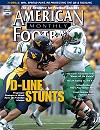AMERICAN FOOTBALL MONTHLY THE #1 RESOURCE FOR FOOTBALL COACHES
Article CategoriesAFM Magazine
|
The Spread Puntby: Mike SabockAssistant Football Coach, Northern Illinios University © More from this issue There are some general concepts I need to mention before we get into the spread punt: 1. Get off time The snapper and the punter are a unit that must work together. By this I mean the faster your snapper is the more time your punter can take. The slower your snapper is the faster the punter must be at getting the ball off. From the snap to the punt, any time over 2.1 seconds increases the chance of a punt being blocked. As a general rule, you would like the snap to take .8 seconds and the punter to catch and punt the ball in 1.3 seconds. You can’t coach the punt team without a stopwatch in your hand! 2. Equal Practice You must work your #1 punt team and your #....The full article can only be seen by subscribers. Subscribe today!
|
|
|||||||
| HOME |
MAGAZINE |
SUBSCRIBE | ONLINE COLUMNISTS | COACHING VIDEOS |
Copyright 2025, AmericanFootballMonthly.com
All Rights Reserved





